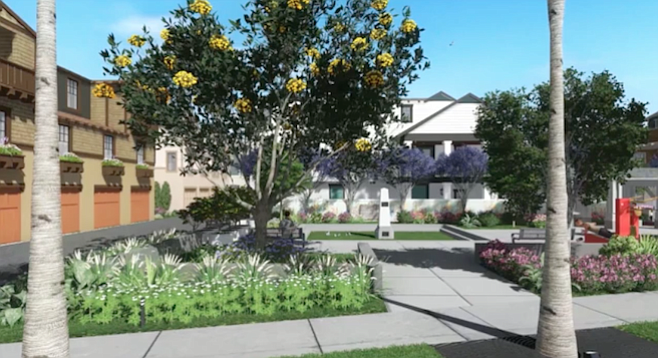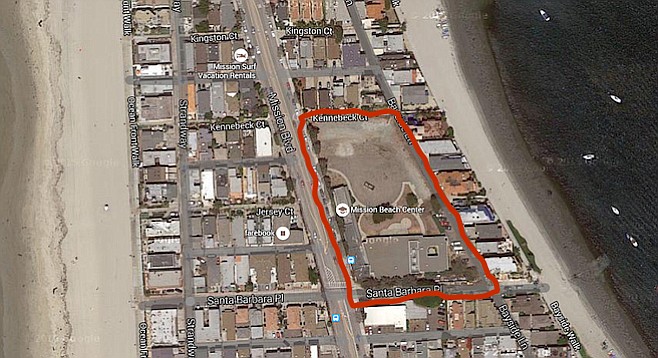 Facebook
Facebook
 X
X
 Instagram
Instagram
 TikTok
TikTok
 Youtube
Youtube

Mission Beach will see the former Mission Beach Elementary School site developed into 59 homes with the California Coastal Commission’s unanimous approval on Thursday (October 12th). The commission was the last stop in the project’s permitting process for the tract of land east of Mission Boulevard between Kennebeck Court (to the north) and Santa Barbara Place (to the south).

Developer McKellar McGowan’s chief executive officer, Chris McKellar, said the company is looking forward to an end in project delays.
“This was the major approval,” McKellar said. “Mission Beach really needs this — what’s there now is a disgrace. It’s dilapidated and fenced so there’s no access or views for blocks.”
Disappointed Mission Beach residents didn’t want to comment after the hearing except to reiterate their argument that the proposed plan isn’t consistent with the community. During the hearing, they spoke passionately about protecting the character of the area, once a community of small houses on small lots, with view corridors prominent and plentiful.
For more than two years, the area’s Precise Planning Board has been fighting the project because, they say, it’s bigger and out of character with the area that was precisely planned by John Spreckels in 1914.
Mission Beach was created on a sandbar purchased by Spreckels. He designed a neighborhood squeezed between the ocean and Mission Bay on 30-foot by 80-foot lots, with larger buildings on the corners. Its elementary school was built on a cluster of those lots and operated until 1987, when the San Diego Unified School District closed it. It was sold for $18.5 million in 2013, over the objections of then-mayor Bob Filner, who wanted it to remain public land.
The 2.3-acre lot is the last of the big land parcels in the community. The city council approved the project in April 2016, after Mission Beach planners challenged a Planning Commission decision that the project could go forward. From there, the project headed to the coastal commission for the final approval.
By the time they arrived at the city hearing, local developers had split the 2.3-acre parcel into two projects, one north of Santa Barbara Place with 51 condominiums in 15 buildings, and the other south of Santa Barbara Place, with 12 homes in four buildings — including the only freestanding single-family home in the project.
The split, Mission Beach planners argued, reduced the size of public park developers had to create. By May, they had filed a CEQA lawsuit against the city and the development.
Coastal commission staff reviewed the plan in May and decided to treat it as a single project, though it came in as two, according to the staff report. The staff asked for fewer units and more park than city planners approved. The developers complied, eliminating four living units from the north part's original 51 and increasing the park size by 59 percent to about a third of an acre. At the commission’s bidding, they reshaped the park from a long triangular strip along Mission Beach Boulevard to a rectangle that will look like a courtyard to project residents on three sides.
The commission also required the park to be dedicated as a city park forever; and they required a traffic study done during high tourist season (the city accepted one done in winter months, which found far less traffic). But they rejected the planners’ technical arguments that developers had used public right-of-way in the calculations for how big each unit could be; the commission also disagreed with arguments that the three-story buildings will be bulky and look out-of-place.
Commissioner Steve Padilla, a Chula Vista city councilman and the only San Diego County representative on the commission, said he supported the revised project. “The staff’s analysis is supported by the facts,” Padilla said. “As far as the dispute over how the calculations were made and how many extra units they might produce…it doesn’t in my mind violate the rules about bulk and scale.”


Mission Beach will see the former Mission Beach Elementary School site developed into 59 homes with the California Coastal Commission’s unanimous approval on Thursday (October 12th). The commission was the last stop in the project’s permitting process for the tract of land east of Mission Boulevard between Kennebeck Court (to the north) and Santa Barbara Place (to the south).

Developer McKellar McGowan’s chief executive officer, Chris McKellar, said the company is looking forward to an end in project delays.
“This was the major approval,” McKellar said. “Mission Beach really needs this — what’s there now is a disgrace. It’s dilapidated and fenced so there’s no access or views for blocks.”
Disappointed Mission Beach residents didn’t want to comment after the hearing except to reiterate their argument that the proposed plan isn’t consistent with the community. During the hearing, they spoke passionately about protecting the character of the area, once a community of small houses on small lots, with view corridors prominent and plentiful.
For more than two years, the area’s Precise Planning Board has been fighting the project because, they say, it’s bigger and out of character with the area that was precisely planned by John Spreckels in 1914.
Mission Beach was created on a sandbar purchased by Spreckels. He designed a neighborhood squeezed between the ocean and Mission Bay on 30-foot by 80-foot lots, with larger buildings on the corners. Its elementary school was built on a cluster of those lots and operated until 1987, when the San Diego Unified School District closed it. It was sold for $18.5 million in 2013, over the objections of then-mayor Bob Filner, who wanted it to remain public land.
The 2.3-acre lot is the last of the big land parcels in the community. The city council approved the project in April 2016, after Mission Beach planners challenged a Planning Commission decision that the project could go forward. From there, the project headed to the coastal commission for the final approval.
By the time they arrived at the city hearing, local developers had split the 2.3-acre parcel into two projects, one north of Santa Barbara Place with 51 condominiums in 15 buildings, and the other south of Santa Barbara Place, with 12 homes in four buildings — including the only freestanding single-family home in the project.
The split, Mission Beach planners argued, reduced the size of public park developers had to create. By May, they had filed a CEQA lawsuit against the city and the development.
Coastal commission staff reviewed the plan in May and decided to treat it as a single project, though it came in as two, according to the staff report. The staff asked for fewer units and more park than city planners approved. The developers complied, eliminating four living units from the north part's original 51 and increasing the park size by 59 percent to about a third of an acre. At the commission’s bidding, they reshaped the park from a long triangular strip along Mission Beach Boulevard to a rectangle that will look like a courtyard to project residents on three sides.
The commission also required the park to be dedicated as a city park forever; and they required a traffic study done during high tourist season (the city accepted one done in winter months, which found far less traffic). But they rejected the planners’ technical arguments that developers had used public right-of-way in the calculations for how big each unit could be; the commission also disagreed with arguments that the three-story buildings will be bulky and look out-of-place.
Commissioner Steve Padilla, a Chula Vista city councilman and the only San Diego County representative on the commission, said he supported the revised project. “The staff’s analysis is supported by the facts,” Padilla said. “As far as the dispute over how the calculations were made and how many extra units they might produce…it doesn’t in my mind violate the rules about bulk and scale.”
Comments